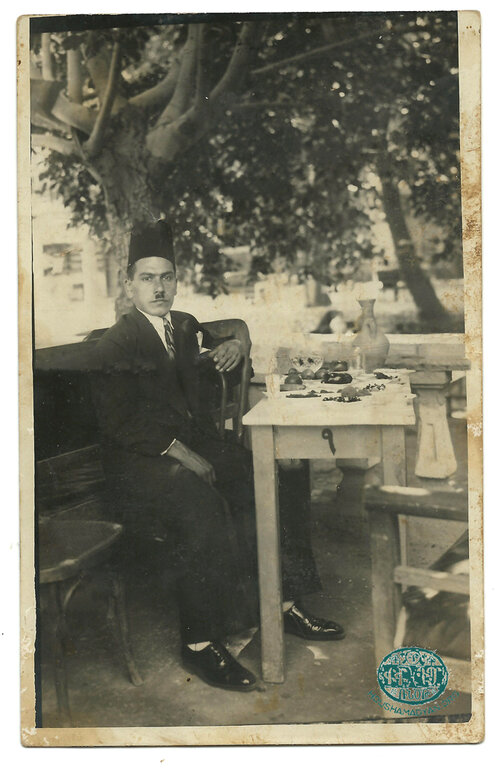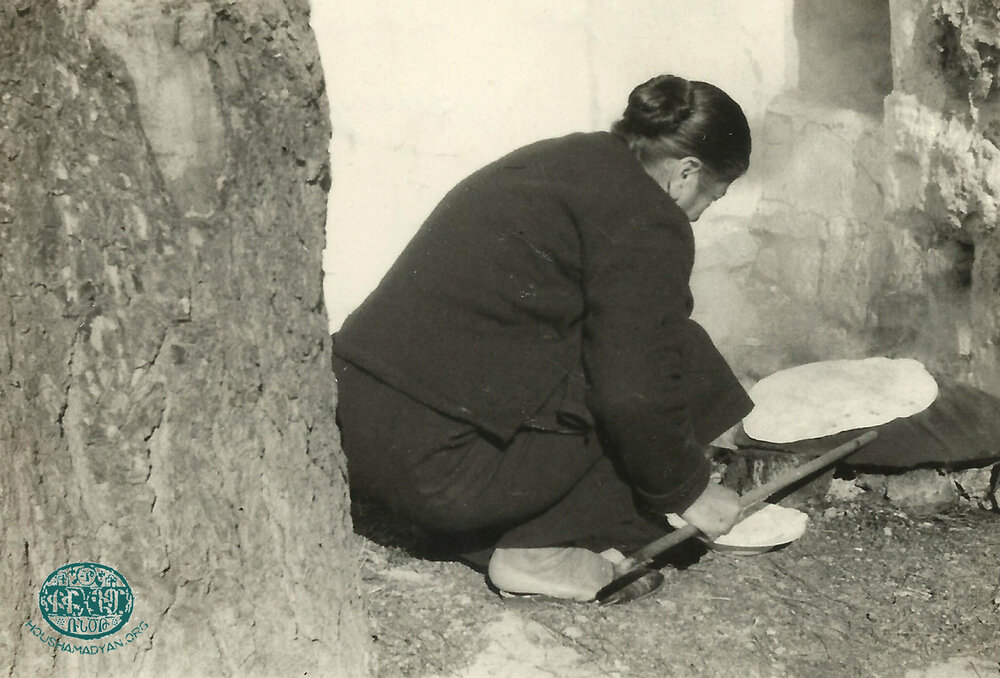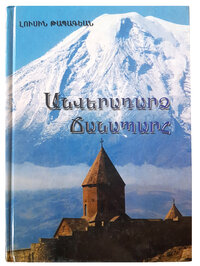Loucine Tabakian collection - Lebanon
Author : Garo Derounian, 12.08.20 / Translator: Simon Beugekian

The material presented on this page was provided to us by Lousin Tabakian. It tells the story of the Akelians and the Tabakians, which are respectively the maternal and paternal branches of Lousin’s family.
Lousin Tabakian’s paternal grandfather was Panos Tabakian, from the city of Marash. He was a baker by profession and lived in the neighborhood of the Saint Sarkis Church, also known as the Khrlakian neighborhood.
Lousin’s paternal grandmother was Ghamer Salibian. Ghamer (kamer) is Turkish for “moon.” Lousin was named in honor of her grandmother (lousin is Armenian for “moon”).
Panos and Ghamer were married in Marash. They had four children: Mariam, Sona, Minas (Lousin’s father), and another daughter whose name is unknown. All their children were born in Marash.
It is unclear what happened to Panos and Ghamer during the years of the Genocide. All we know is that they don’t appear in the family’s post-Genocide history. Much more accurate information regarding their children has been passed down to Lousin.
After the Genocide, Mariam found shelter in the orphanage of Jerusalem. She married a fellow orphan from Marash with the surname Chtrdjian. They had one son, Manuel, who later migrated to Soviet Armenia.
Sona also found refuge in an orphanage. In her case, it was the AGBU Kelegian orphanage in Beirut. She, too, later married a fellow orphan, and together their emigrated to France.

Lousin Tabakian’s father was Minas Tabakian. He was a baker like his father. While still in Marash, he married Arousiag Akelian, and together they had five children, the first of whom was born in Marash. They were Meline (born in Marash), Anna (born in Salamiyah), Hovhannes (born in Beirut in the early 1920s), Antranig (born in Beirut at an unknown date), and Lousin (born in Beirut, in the Nor Marash neighborhood, in 1934).
During the years of the Genocide, Minas Tabakian and his family were deported from Marash. They settled down in the town of Salamiyah, which is currently in the territory of Syria, east of Homs and Hama. We know that Minas somehow found a way to escape Salamiyah. He made his way to Iskenderun, where conditions were better, and where he worked as a baker. But after some time, he wished to reunite with his family. He tied the coins he had earned to his belt and set off back towards Salamiyah, but he was attacked on the way and robbed of his money.
The family’s oral history has also retained a story of a Bedouin woman trying unsuccessfully to kidnap Meline in Salamiyah. Meline died at some point during the years of the Genocide.
After the Armistice, it is not clear if the family, like the majority of Armenians from Cilicia, were resettled in Marash. We only know that in late 1921, when masses of Cilicia Armenians arrived in Beirut and settled down in the large refugee camp near the city port, Minas had his own bakery at the entrance of the tent city.
In early 1933, a large fire ravaged the camp, burning down most of the homes of the refugees. The home and bakery of the Tabakian family were also destroyed. As a result of the terror he had endured, Minas suffered a stroke, resulting in partial paralysis of his body.

Later, Minas and his family moved to the Nor Marash (New Marash) neighborhood of Bourj Hammoud. Minas continued to work as a baker, but due to his handicap, he could not run his own bakery. Instead, he worked as an employee for other bakers. He died in October 1944.
Minas and Arousiag’s daughter, Anna, married Boghos Arslanian at the age of 18, and had one son and four daughters with him.
Minas and Arousiag’s son, Hovhannes, graduated from the seminary of Antelias. He served as a teacher at the Forty Martyrs School of Nor Marash and as the choirmaster of the eponymous church. He later served as the choirmaster of the Holy Virgin Church of the Nor Adana neighborhood and as a teacher at the adjacent Apkarian School. We also know that he taught at the AGBU Yervant Dermirdjian School.
Hovhannes’s brother, Antranig, also attended the Forty Martyrs School. He became a seamster (shirt maker). He married Zabel Keshishian, also from Marash. They had one son and one daughter.
Lousin also attended the Forty Martyrs School of Nor Marash, after which she transferred to the Armenian Evangelical College. She received her higher education at Haigazian University. From 1962 to 2002, she worked at the Levon Nazarian School of the Armenian General Benevolent Union (AGBU). She took on various responsibilities in community organizations, including the Women’s Board of the AGBU Rmeil chapter, the Tekeyan Cultural Association, the Antranig-Sevan chapter of the Armenian Youth Society, etc. She is the author of two books.
Lousin Tabakian’s mother, as we have mentioned, was Arousiag (nee Akelian). We also know her mother’s name, Mariam (nee Ganimian). Arousiag Akelian lived in Marash and was one of four sisters and five brothers. Her sisters were Almasd (later Chinchinian), Feride (later Ganimian), and Haiganoush (later Dilenian). Her brothers were Hovhannes (killed in Marash under unknown circumstances), Sdepan, Sarkis, Haigaz, and George.
Sdepan, Sarkis, Haigaz, and their nephew Harry Chinchinian (Almasd’s son) all migrated to the United States before the Genocide. There, in the city of Watertown (near Boston), they were founding and prominent members of the Marash Compatriotic Union.

The seated man wearing the fez is Minas Tabakian. Behind him, with her hand on Minas’s shoulder, is his wife, Arousiag Tabakian (nee Akelian). On Arousiag’s right, standing, is Minas Tabakian’s sister. On the right of Minas, seated, is Arousiag’s mother, Mariam Akelian (nee Ganimian). On the right of Mariam, standing, is little Anna Tabakian, Arousiag and Minas’s daughter. On Minas’s left is his son, Hovhannes Tabakian. This photograph was taken in the second half of 1920s, during the time when the Tabakian family was still living in the refugee camp of Beirut.



1. Leon Ganimian, 1914, United States. He was the brother-in-law of Feride, Arousiag Akelian’s sister. Later, after the death of Feride’s husband, he married her.
2. The seated man is Minas Tabakian. The others, standing, are the children of Haiganoush Dilenian, sister of Arousiag Tabakian (nee Akelian). From left to right: Berdjanoush, Haigouhi, and Movses.























